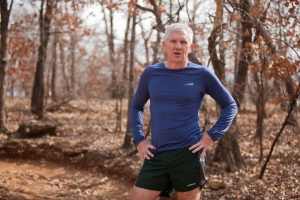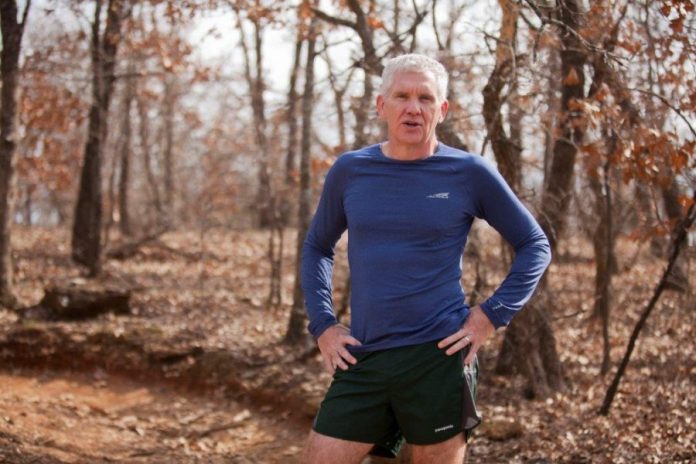
There are distance runners … and then there is Joe Curren.
After conquering the familiar road-running events– including 5K, 10K, half-marathon and marathon a long time ago– he has now moved on to the sport of Ultra Trail Running.
The extreme distance sport entails running as many as 30-hours at a time for distances of up to 100-miles; and, for Curren, 53, it has become a way of life.
“Trail running is both a good alternative and complement to road-running,” Curren said. “I like the re-connection to nature and the lower physical impact. Surprisingly, trail-running can offer a harder mental challenge. While road-running is often of a higher intensity, trails require a higher level of mental focus to avoid roots, rocks and unexpected twists.”
Ultras are any distance above a marathon (26.2-miles), with the most popular distances being 50-kilometers, 50-miles, 100-kilometers and 100-miles.
While marathon training is focused on pace and speed, ultra training usually adds significant time and distance to training plans and logistical considerations like weather, terrain (everything from flat, soft courses to high-altitude mountains), nutrition (eating on a planned interval for more than 24-hours), plus running with a pacer and crew support.
“I like the planning and execution almost as much as the running itself,” Curren said.
The Flower Mound man started trail running about 10 years ago as alternative to what, for him, was “becoming a routine on the road.”
“I had some friends who ran trails, so they took me along,” Curren said. “I couldn’t believe how much harder it was. I had already been running for more than 10 years, but this was a new challenge. Somewhere along the way, my friend, Rich, was invited to crew and pace his friend at the Leadville 100 in Colorado. He told me he was planning to run 50-miles and asked if I thought he could do it. I thought he said 15, so I told him: ‘Of course.’
“When I figured out it was 50, I told him he was crazy. Well, he did that and started running his own ultras. He sort of led the way for me. Once I saw someone I knew doing it, I had to try.”
Curren ran his first 50k in 2012 at the Rockledge Rumble on Grapevine Lake; then, there was a 50-mile run in New Mexico in 2013; and, eventually, the Leadville 100 in 2014, with a goal of getting 60-miles.
“That would have been a personal best for me on a hard, high-altitude course,” Curren said. “With a lot of help, I ended up finishing the whole 100 miles in 29:48, which was only 12 minutes before the cutoff.”
Curren has had a lot of enjoyment from Ultra Trail Running, but not everything has always worked out as planned, either.
At the 2018 Wasatch 100 in Utah, a race that involves more than 27,000-feet of climbing, Curren was unable to finish; and, it affected him.
“I learned more about myself in that race than any other,” he said. “Ultra running has taught me a lot. The most important lesson is the importance of social connection. No one finishes an ultra without the support of those that planned and manage the race. Every race has volunteers at aid stations and supporters along the way. Most runners have a crew and/or pacers (friends that run alongside you in the late stages of the race).”
Curren was not down for long, however, bouncing back from the disappointment at Wasatch with one of his best runs ever in February, competing in the Rocky Racoon 100-mile Race in Huntsville.
“Rocky Raccoon is a much flatter course, but not easy, with simpler logistics,” Curren said. “The course is four, 25-mile loops, which makes it easier to build some course knowledge and manage gear changes and food resupplies. I finished in 26:48, a little slower than planned, but still my best 100-mile time.”
Curren said he usually runs five days a week to train. Some days are speed-focused, while some are at a steady pace and some are easy or recovery days. He typically runs longer on Saturdays and Sundays, averaging five- or six-hours per run.
“It evolves over time, building up durations over a three-week period, followed by a recovery week,” Curren said. “As the race nears, there is usually a taper period of two weeks that cuts time on the feet and allows the runner to go into the race strong, but rested. The most I’ve run in a month is 212-miles. Sounds like a lot, but I have friends that do twice that much.”
Joe Curren’s wife, Kim, is a hiking enthusiast who said she enjoys the “trail environment,” though she is not a distance runner herself.
She is Joe’s biggest supporter and said watching his love for the sport of ultra trail-running grow has been very special for her.
“Joe’s dedication to his passion is truly inspiring,” she said. “I think for him personally, his training-discipline helps him to be successful. For instance, if it’s summertime, he will forgo sleeping-in a little on Saturday and Sunday in order to run before it gets too hot. There have been times when he has gone running before the sun rises wearing a head lamp for light.
“He sticks to his training plan as closely as he can, no matter how long of a race he is training for. If he is supposed to run a certain number of training miles one day– and his route falls even just a bit short– he will make up that distance before he’s through.”
She added that she and her husband meticulously prepare for each run and that a lot of planning goes into the process between the two of them.
“Prior to the actual race, he will put together a race plan for me with the time frame that he estimates he will arrive at each of the aid stations along the way,” she said. “This requires his careful calculations of the terrain and elevation gain of each segment, as well as whether that segment falls early or later on in the race. If he ends up running faster or slower than he expected, I will adjust his arrival times accordingly. At the aid stations, I help refill his water bottles and help him with any issues with his gear and just offer moral support.”
Curren said he has fallen in love with the sport of Ultra Trail Running and said he has a bit of advice for anyone thinking about attempting to run an event.
“I’d say if you’re interested, get out there and try it,” he said. “My first trail run and my first ultra were on the same trail, Northshore Trail on Grapevine Lake. You can just run for fun or you can sign up for a race and go do it. Trail-races usually start around 10k (6.2 Miles), which may sound long at first, but is entirely doable. You’ll find that the trail-running community is extremely supportive. No one will judge your style, your pace or your goals. They all want you to succeed … and there is nothing like crossing that line.”











.jpg)


